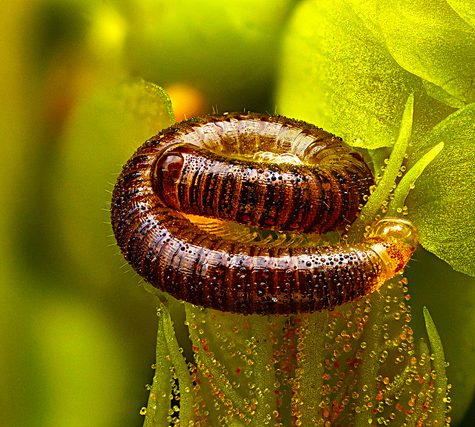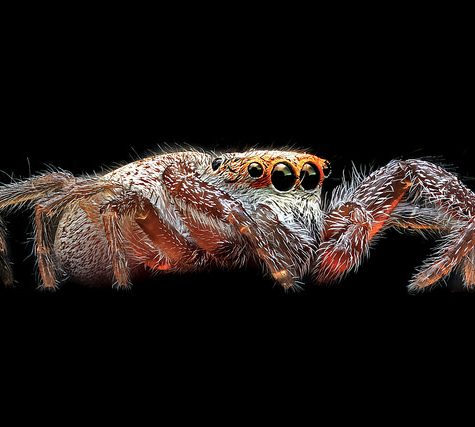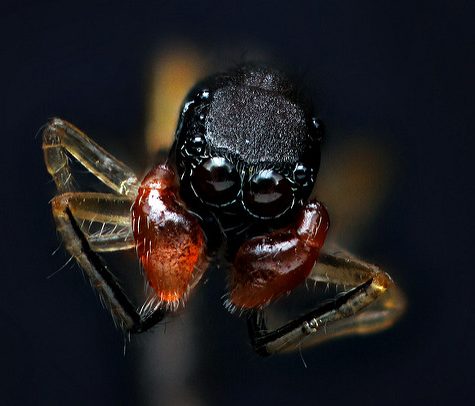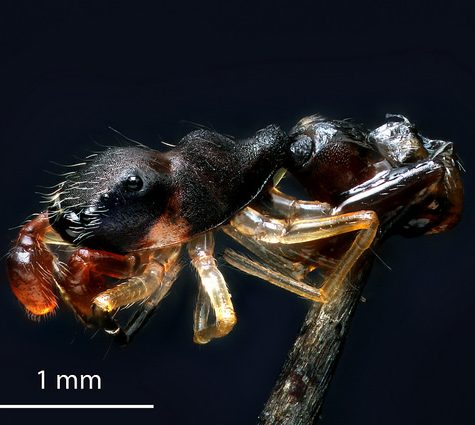Phidippus princeps
$19.00 – $400.00Phidippus princeps is a rare species of jumping spider found in Canada and the United States. These jumping spiders’ vision exceeds by a factor of ten that of dragonflies, which have the best vision among insects.

Phidippus princeps is a rare species of jumping spider found in Canada and the United States. These jumping spiders’ vision exceeds by a factor of ten that of dragonflies, which have the best vision among insects.

Ant mimicry or myrmecomorphy is mimicry of ants by other organisms. Ants are abundant all over the world, and potential predators that rely on vision to identify their prey, such as birds and wasps, normally avoid them, because they are either unpalatable or aggressive. Some arthropods mimic ants to escape predation (protective mimicry), while others mimic ants anatomically and behaviourally to hunt ants (aggressive mimicry).[1]
To overcome ants’ powerful defences, mimics may imitate ants chemically (Wasmannian mimicry) with ant-like pheromones, visually (as in Batesian mimicry, though the purpose may also be aggressive mimicry), or by copying microstructure for tactile mimicry.[2]

Myriapoda is a subphylum of arthropods containing millipedes, centipedes, and others. The group contains over 16,000 species, most of which are terrestrial.[2]Although their name suggests they have myriad (10,000) legs, myriapods range from having up to 750 legs (the millipede Illacme plenipes)[3]to having fewer than ten legs.

Hentzia is a genus of the spider family Salticidae (jumping spiders).

Dermacentor variabilis, also known as the American dog tick or wood tick, is a species of tick that is known to carry bacteria responsible for several diseases in humans, including Rocky Mountain spotted fever and tularemia (Francisella tularensis). It is one of the most well-known hard ticks. Diseases are spread when it sucks blood from the host, which could take several days for the host to experience some symptoms.

A pseudoscorpion, also known as a false scorpion or book scorpion, is an arachnidbelonging to the order Pseudoscorpiones, also known as Pseudoscorpionida or Chelonethida.
Pseudoscorpions are generally beneficial to humans since they prey on clothes moth larvae, carpet beetle larvae, booklice, ants, mites, and small flies. They are tiny and inoffensive, and are rarely seen due to their small size, despite being common in many environments. Pseudoscorpions often carry out phoresy, a form of commensalism in which one organism uses another for the purpose of transport.

Hentzia is a genus of the spider family Salticidae (jumping spiders).

Wolf spiders are members of the family Lycosidae, from the Ancient Greek word “λύκος” meaning “wolf”. They are robust and agile hunters with excellent eyesight. They live mostly in solitude and hunt alone, and do not spin webs. Some are opportunistic hunters pouncing upon prey as they find it or even chasing it over short distances. Some will wait for passing prey in or near the mouth of a burrow.

Phidippus princeps is a rare species of jumping spider found in Canada and the United States. These jumping spiders’ vision exceeds by a factor of ten that of dragonflies, which have the best vision among insects.

Ant mimicry or myrmecomorphy is mimicry of ants by other organisms. Ants are abundant all over the world, and potential predators that rely on vision to identify their prey, such as birds and wasps, normally avoid them, because they are either unpalatable or aggressive. Some arthropods mimic ants to escape predation (protective mimicry), while others mimic ants anatomically and behaviourally to hunt ants (aggressive mimicry).[1]
To overcome ants’ powerful defences, mimics may imitate ants chemically (Wasmannian mimicry) with ant-like pheromones, visually (as in Batesian mimicry, though the purpose may also be aggressive mimicry), or by copying microstructure for tactile mimicry.[2]

Latrodectus is a genus of spiders in the family Theridiidae, most of which are commonly known as widow spiders. The genus contains 31 recognized species[2] distributed worldwide, including the North American black widows (L. mactans, L. hesperus, and L. variolus), the button spiders of Africa, and the Australian redback spider. Species vary widely in size. In most cases, the females are dark-coloured and readily identifiable by reddish markings on the abdomen, which are often (but not always) hourglass-shaped.
The venomous bite of these spiders is considered particularly dangerous because of the neurotoxin latrotoxin, which causes the condition latrodectism, both named after the genus. The female black widow has unusually large venom glands and its bite can be particularly harmful to humans. However, despite the genus’ notoriety, Latrodectus bites are rarely fatal. Only female bites are dangerous to humans.

Ant mimicry or myrmecomorphy is mimicry of ants by other organisms. Ants are abundant all over the world, and potential predators that rely on vision to identify their prey, such as birds and wasps, normally avoid them, because they are either unpalatable or aggressive. Some arthropods mimic ants to escape predation (protective mimicry), while others mimic ants anatomically and behaviourally to hunt ants (aggressive mimicry).[1]
To overcome ants’ powerful defences, mimics may imitate ants chemically (Wasmannian mimicry) with ant-like pheromones, visually (as in Batesian mimicry, though the purpose may also be aggressive mimicry), or by copying microstructure for tactile mimicry.[2]

Ant mimicry or myrmecomorphy is mimicry of ants by other organisms. Ants are abundant all over the world, and potential predators that rely on vision to identify their prey, such as birds and wasps, normally avoid them, because they are either unpalatable or aggressive. Some arthropods mimic ants to escape predation (protective mimicry), while others mimic ants anatomically and behaviourally to hunt ants (aggressive mimicry).[1]
To overcome ants’ powerful defences, mimics may imitate ants chemically (Wasmannian mimicry) with ant-like pheromones, visually (as in Batesian mimicry, though the purpose may also be aggressive mimicry), or by copying microstructure for tactile mimicry.[2]

Spiders have primarily four pairs of eyes on the top-front area of the cephalothorax, arranged in patterns that vary from one family to another.[8] The principal pair at the front are of the type called pigment-cup ocelli (“little eyes”), which in most arthropods are only capable of detecting the direction from which light is coming, using the shadow cast by the walls of the cup. However, in spiders these eyes are capable of forming images.[19][20]The other pairs, called secondary eyes, are thought to be derived from the compound eyes of the ancestral chelicerates, but no longer have the separate facets typical of compound eyes. Unlike the principal eyes, in many spiders these secondary eyes detect light reflected from a reflective tapetum lucidum, and wolf spiders can be spotted by torch light reflected from the tapeta. On the other hand, jumping spiders’ secondary eyes have no tapeta.[8]

Latrodectus is a genus of spiders in the family Theridiidae, most of which are commonly known as widow spiders. The genus contains 31 recognized species[2] distributed worldwide, including the North American black widows (L. mactans, L. hesperus, and L. variolus), the button spiders of Africa, and the Australian redback spider. Species vary widely in size. In most cases, the females are dark-coloured and readily identifiable by reddish markings on the abdomen, which are often (but not always) hourglass-shaped.
The venomous bite of these spiders is considered particularly dangerous because of the neurotoxin latrotoxin, which causes the condition latrodectism, both named after the genus. The female black widow has unusually large venom glands and its bite can be particularly harmful to humans. However, despite the genus’ notoriety, Latrodectus bites are rarely fatal. Only female bites are dangerous to humans.

The evolution of spiders has been going on for at least 380 million years, since the first true spiders (thin-waisted arachnids) evolved from crab-like chelicerate ancestors. More than 45,000 extant species have been described, organised taxonomically in 3,958 genera and 114 families.[1] There may be more than 120,000 species.[1] Fossil diversity rates make up a larger proportion than extant diversity would suggest with 1,593 arachnid species described out of 1,952 recognized chelicerates.[2] Both extant and fossil species are described yearly by researchers in the field (see External links for most recent list of fossil species). Major developments in spider evolution include the development of spinnerets and silk secretion.